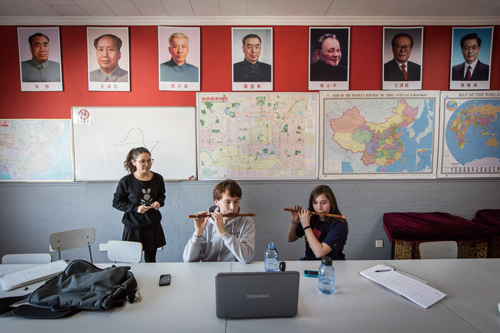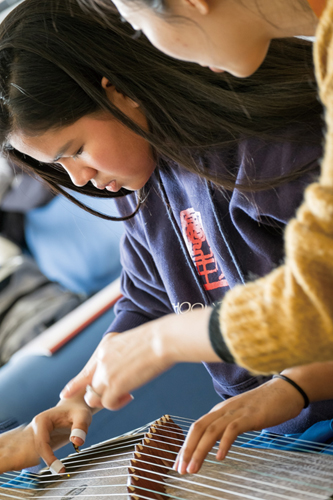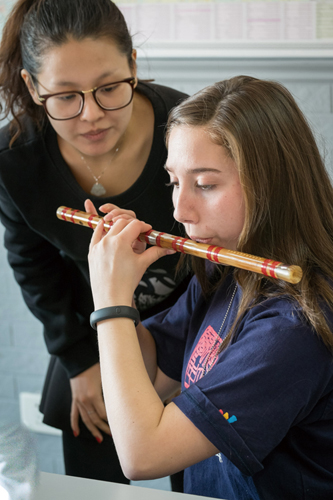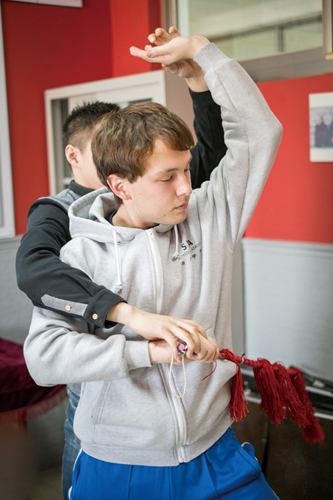
Traditional Chinese music faces a tough battle for the hearts, minds, and iPods of a new generation. Amidst the rise of western imports and home-grown C-pop, there seems to be less and less space for the songs that provided a soundtrack to Chinese history for centuries.
Even if the tunes of old live on, the ancient instruments that performed them are playing an increasingly marginalized role in modern society. Classical western instruments are now more widely taken up by Chinese children, some of whom may only see their ancestral music performed in the name of tourist donations.
One person hoping to buck the trend is Helena Yang who founded CNethnic six years ago, an organization offering lessons with traditional instruments to local and expat children alike. It currently provides classes for Study Year Abroad (SYA), an exchange program in which international students live with local families and study at Beijing Normal University High School No. 2.
Although many of them had never even heard of instruments like guzheng and erhu before coming to Beijing, they are now in their second term of lessons, having just
performed a Christmas concert to parents and other students.
So how difficult is Chinese music for young western ears? And how many of the students will keep up their newfound skill when they return home? CNethnic and SYA invited beijingkids to find out.
Resources
CNethnic
CNethnic is an organization dedicated to providing training, demonstrations, and exhibitions of Chinese folk music and dancing. Students aged 5 and above can take part in programs in a variety of traditional Chinese instruments. Currently, lessons take place at a number of international schools, including CIS, ISB, BCIS, and WAB, although private lessons will soon be available. CNethnic also produces a range of DVD and book sets to help self-learners. For more information, visit
www.cnethnic.com, email service@cnethnic.com, or call the hotline on 6526 8132.
Study Year Abroad (SYA)
SYA China is a cultural exchange program in which international students spend a year in Beijing living with a local family and taking part in a special curriculum at Beijing Normal University High School No. 2. As well as advancing their Chinese language skills, the exchange students enjoy a wide variety of extracurricular activities which, in addition to traditional music, include theater, cooking,
dancing, and more. For more information on the program or the admissions process, visit www.sya.org.

Guzheng 古筝
Fitted with anything from 12 to 26 strings and available in a variety of sizes, the guzheng is played with finger picks taped to the instrumentalist’s hands. The lingering, mystical tone of a plucked guzheng produces one the most archetypal Chinese sounds (to western ears at least). This is one of the reasons 17-year-old Audrey Fritz from Washington DC and 16-year-old Anika Huq (pictured right) from Boston chose to learn the instrument after being presented with a range of options at the beginning of term. “It’s a really typical sound,” says Fritz.
The pair was modest about the Christmas concert and Huq thinks that one of the qualities of the instrument is that it can carry you through a performance. “If you make a mistake it still sounds wonderful,” she jokes.
This may make the instrument a good choice for beginners but there is a steep learning curve, according to the girls’ teacher Shi Lin. “Maybe it’s a little bit easier to begin with, but to take it to the next level needs a lot of hard work,” she says.
Experience with the piano can be useful and Huq says that knowing some guitar made it a little easier, but the girls agree that they find the instrument challenging. Nonetheless, the two young students play the guzheng deftly and are working towards more advanced pieces that require multiple strings to be plucked at once.
Type: String
History: Believed to have been invented in either the warring states period of 475 to 221 B.C. or the Qin Dynasty (897-221 B.C.). Historians suggest that it was the country’s most popular instrument during the Tang Dynasty (A.D. 618 to 907).
Technique: The strings on the right hand side are plucked, with those on the left pressed down to produce new notes and a vibrato effect.
Similar western instruments: Guitar, piano, xylophone, and harp

Erhu 二胡
The erhu is a two-stringed Chinese fiddle played with a bow. Unlike a violin, the horse hair bow is attached to the instrument and slides against the inside of the strings, which are traditionally tuned to D and A.
There are certainly similarities with western string instruments. Experience playing violin helped 17-year-old Michael Bite make strides with the instrument, although it requires “a completely different movement” when playing, he says. But it was not simply the familiarity of the instrument that that led him to taking up the erhu in Beijing.
“I saw a video of a famous erhu song and it was a really intense piece,” he explains. “So when I came to China I thought: ‘I’m going to roll with this.’”
Erhu teacher Wang Yun stresses that the instrument is “difficult,” although she appears impressed with the ability of the class, which performed carols alongside a popular Chinese folk song, “Jasmine Flower,” at the recent Christmas concert.
“The students’ musical knowledge is higher than that of Chinese students of the same age,” she says. “Most have experience playing other instruments, which is advantageous.”
Whether the instrument has captured the student’s imaginations enough to see them continue upon returning home to the US is uncertain, though they seem enthusiastic enough.
“I’ve already bought one,” says 18-year-old Wisconsin native Meghan Murphy, although all the students agree that they might find it a little difficult to find good teachers back home.
Type: String
History: Understood to have
developed from string instruments brought into China from central Asia in the tenth century.
Technique: Played with a horse hair bow, using the left hand to press on the strings and alter the tone.
Similar western instruments: Violin, viola

Chinese Bamboo Flute 笛子
There is a huge range of Chinese flutes that vary depending on the playing technique, the material used, and the way in which the sound is produced. The instrument that the SYA class uses is of the nine-holed bamboo variety.
While it may appear to have similarities with a recorder, the lack of a fixed mouthpiece or reed makes prior experience playing a western flute or piccolo most useful, according to teacher Wang Yun.
“To make the sound stronger or weaker you must control your breath and mouth shape,” she says. “The fingering technique [of flute and recorder]is the same though.”
Nonetheless, the bamboo flute’s relative simplicity may make it a good choice for beginners like 16-year-old Alison Kubick, who has never played an instrument before and has “absolutely no musical background,” in her own words.
She remarks that her classmate is “much better” than her, but plays a credible rendition of a simple traditional song, the notes of which are drawn out on the whiteboard at the front of the class.
“I think I’ll try and keep it up when I get back home,” she says.
If she does, she will be taking back a piece of Chinese history. The instrument stretches far back in time and Yun says that, along with the early reed instrument sheng, the Chinese bamboo flute is “one of the most ancient instruments.”
Type: Woodwind
History: Images of flute-like
wooden instruments in China date back as far 1100 B.C.
Technique: Players alter the tone using the finger holes and the volume and cadence with the shape of the mouth and breathing technique.
Similar western instruments: Flute, piccolo

Peking Opera 京剧
Although not an instrument in the physical sense, the unique singing used in Chinese opera is as distinctive as the mystical twang of a guzheng. The stark differences in the vocal technique used, not to mention the fact that words are sung in Mandarin, were a challenge for 16-year-old Andrew Medina, whose initial interest in the art form stemmed from his experience singing in the US.
“It’s completely different,” he says.
“Singing a song in Chinese is also about elevating your voice at certain points and sometimes you have to hold a note for 20 or 30 seconds, going up and down.”
But as with opera in the West, this art form is not simply about the music, but also storytelling and dramatic performance, explains CNethnic’s founder, Helena Yang.
“It’s a mixture of singing, acrobatics, and movement,” she says. “Peking opera has its background in historical stories.”
Having spent the first term working on the singing technique, we joined Medina as he practiced the dramatic side of Peking opera with a tasseled baton that traditionally represents a horse. Having taken part in musical theater back in the US, the performance element may not be entirely new for him, though his first public display at the Christmas concert presented some cultural surprises.
“I had to wear a costume and dress like an old man with a fake beard made of horse hair,” he recalls. “The story was about a man who wants to fight for his country but keeps falling asleep.”
Type: Singing/dance/performance
History: Peking opera evolved from Anhui opera that arrived in Beijing in 1790 and exploded in popularity throughout the 1900s.
Technique: Notes are produced along a sliding scale to allow seamless transition between speech and song, while visual performance comprises dance-acting with acrobatics and fight scenes.
Similar western art forms: Opera, musical theater, mime
Photos by Mitchell Pe Masilun
This article originally appeared on p62-67 of the beijingkids February 2014 issue.
Check out the PDF version online at Issuu.com



